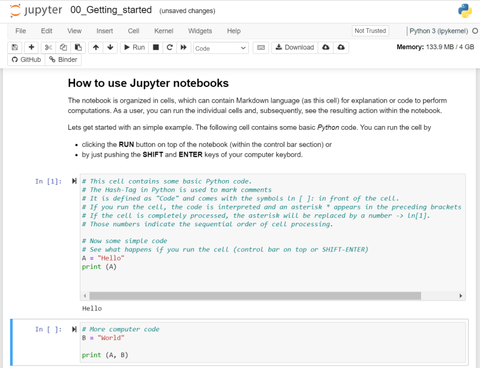Jupyter Notebooks
Jupyter Notebooks are interactive documents that contain information in the form of text, images and videos, for example. This information is combined with program code that can be executed directly within the document. Python is often used as the program code.

A Jupyter Notebook with a text cell and computer code
Jupyter Notebooks can be used platform-independently with a browser, e.g. on a PC but also with a tablet or smartphone. Jupyter Notebooks can cover a wide range of applications, e.g.
- Displaying functional relationships as interactive diagrams,
- Conceptual understanding of groundwater systems by simulating them,
- Worksheets combining explanations, tasks and methodical elements such as calculations,
- Interactive and digital methods such as pumping test evaluation,
- numerical modeling,
- and much more.
A general insight into the use of Jupyter notebooks in teaching can be found on the Jupyter4Edu page
A first impression of the Jupyter Notebooks, which are developed in iNUX, can be found in the GitHub-based compilation or directly in the GitHub repository
If you would like to try out a first Jupyter notebook, you are welcome to access it online using the following link: Interactive access to the iNUX Jupyter notebooks with MyBinder. When opening the page for the first time, it may take a little longer for the page to open completely (up to a few minutes - subsequent access usually takes a few seconds). For a first impression and further information, you can run the notebook 00_Getting_started.ipynb.
